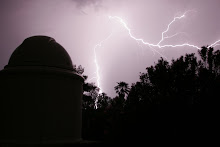
It's day four of Okie-Tex and I'm still having a blast. A bit tired perhaps, but that's because there's not much time for sleep after all the fun stuff going on.
It's been clear every night so far, but that may change soon. The nights have been very calm and chilly, perfect imaging weather. The skies have not been perfect in terms of transparency and seeing conditions, but the clearness seems to make up for it. My mount is mostly behaving well - a few glitches with pier flips but we may have solved that, since it ran successfully last night. I have a bunch of data to process now, much of it color data since the darker skies provide better results in color than back home in the big city. My Sky Quality Meter has been giving readings of approximately 21.65 each night.
The Milky Way is positioned well, visible horizon-to-horizon. The moon has been absent as it goes through its new phase, just what we want. After I got my run going last night, I spent a lot of time doing visual observing with Glenn Sanner and Bob Kepple, authors of the Night Sky Observers Guide. I see them regularly at the Huachuca Club meetings and they are a couple of great guys. We had some fantastic views of various celestial delights including some of the more obscure, faint objects as well as some more popular ones. We spent a lot of time exploring the details in various portions of the Veil Nebula for instance.
The hills nearby provide some nice hiking opportunities and I've found a spot on top of a nearby hill that actually allows me to get a cell phone signal. There is so much open land around here, just what I needed for a little attitude adjustment.
I've had a lot of help as well as plenty of good times with various friends, many of whom I have met at star parties or conferences. To name a few, Rockett, Kent, Jim, Fred, James, Doug, etc...and of course Dean and I have been partying it up. A good star party includes lots of good observing but the people are what really makes it worth attending.
Here's an image that I took the first night. The bright star near the top is Gamma Cassiopeiae, and the nebulosity is known as Sharpless 2-185. It's unlikely that an eyepiece would reveal the nebula, but the camera shows both emission (red) and reflection (blue) components in this Hydrogen dominated cloud.

No comments:
Post a Comment